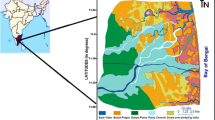Abstract
Groundwater pollution in the vicinity of a landfill site in Nagpur, India is assessed with the help of resistivity imaging and GPR tools. The resistivity imaging survey indicates high conductive anomalies in the topsoil as well as the underlying fractured rocks. Significant reflections from the GPR records known as radargrams are extracted with the help of maximum peak module and Hilbert transform module in RADAN 6. These reflections can be attributed to presence of fractures, which are potential pathways for migration of the fluid. The geophysical findings are strengthened by the results of groundwater analysis from wells located close to the profile where resistivity and GPR survey have been carried out. The study has indicated the vulnerability of the unconfined aquifer underlying the predominantly clay layer.
Similar content being viewed by others
References
AGI (2004) Earth Imager software version 1.7.9.
Annan, A. P., & Cosway, S. W. (1994). GPR frequency selection (pp. 747–760). 5th Int. Conf. on Ground Penetrating Radar, Waterloo, Ontario.
Atekwana, E. A., Sauck, W. A., & Werkema, D. D. Jr. (2000). Investigations of Geoelectrical signatures at a hydrocarban contaminated site. Journal of Applied Geophysics, 44, 167–180.
Bernstone, C., & Dahlin, T. (1997). DC resistivity mapping of old landfills: two case studies. European Journal of Engineering and Environmental Geophysics, 2, 127–136.
Buselli, G., Barber, C., Davis, G. B., & Salama, R. B. (1990). Detection of Groundwater contamination near waste disposal sites with transient electromagnetic and electrical methods. In S. H. Ward (Ed.), Geotechnical and environmental geophysics (pp. 27–40). Tulsa, OK, USA: SEG.
Farquharson, C. G., & Oldenberg, D. W. (2003). Constructing piece-wise-constant models using general measures in non-linear, minimum-structure inversion algorithms. 6th International Symposium of the Society of Exploration Geophysicists of Japan, Tokyo, January 22–24.
Forde, M. C. (1996). Accuracy of GPR on contaminated land. In: Proc. 4th Int. Conference on Polluted and Marginal Land, London, pp. 443–450.
Frohlich, R. K., & Urish, D. W. (2002). The use of geoelectrics and test wells for the assessment of groundwater quality of a coastal industrial site. Journal of Applied Geophysics, 50, 261–278.
Green, A., Lanz, E., & Maurer, H. (1999). A template for Geophysical investigations of small landfills. Leading Edge, 18, 248–254.
Knight, R. (2001). Ground penetrating radar for environmental applications. Annual Review of Earth and Planetary Sciences, 29, 229–255.
Kobr, M., & Linhart, I. (1994). Geophysical survey as a basis for regeneration of waste dump, Halde 10, Zwickau, Saxony. Journal of Applied Geophysics, 31, 107–116.
Lanz, E., Jemmi, L., Muller, R., Green, A., Pugin, A., & Huggenberger, P. (1994). Integrated studies for Swiss waste disposal sites: Results from georadar and other geophysical surveys. Proceedings of the 5th International Conference on Ground Penetrating Radar (GPR’94), Kitcher, Ontario, 1261–1274.
Loke, M. H. (1999). Lecture notes in Electrical Imaging Workshop. 5th Annual Meeting of EEGS-ES, Budapest, Sept 6–9, 1999.
McCann, D. M. (1994). Geophysical methods for the assessment of landfill and waste deposit sites, a review. Land Contamination and Reclaimation, 2, 73–83.
Meju, M. A. (2000). Geoelectrical investigation of old/abandoned covered landfill sites in urban areas: Model development with a genetic diagnosis approach. Journal of Applied Geophysics, 44, 114–150.
Mota, R., Monteiro Santos, F. A., Mateus, A., Marques, F. O., Gonçalves, M. A., Figueiras, J., et al. (2004). Granite fracturing and incipient pollution beneath a recent landfill facility as detected by geoelectrical surveys. Journal of Applied Geophysics, 57, 11–22.
Orlando, L., & Marchesi, E. (2001). Georadar as a tool to identify and characterize solid waste dump deposits. Journal of Applied Geophysics, 48, 163–174.
Padaraze, I., & Forde, M. C. (1994). Limits of effectiveness of digital impulse radar in contaminated land site investigation. In: Proc. 3rd Int. Conf. on Polluted and Marginal Land, 397–401.
Parker, W. L. (1977). Understanding inverse theory. Annual Review of Earth and Planetary Sciences, 5, 35–64.
Porsani, J. L., Filho, W. M., Elis, V. R., Shimeless, F., Dourado, J. C., & Moura, H. P. (2004). The use of GPR and VES in delineating a contamination plume in a landfill site: A case study in SE Brazil 55, 199–209.
Pujari, P. R. (1998). Stabilized analytic signal algorithm in 2D/3D DC resistivity data analysis. PhD thesis, Indian Institute of Technology, Roorkee, Uttaranchal India.
Pujari, P. R., & Deshpande, V. A. (2005). Source apportionment of groundwater pollution around landfill site in Nagpur, India. Environmental Monitoring and Assessment, 111, 43–54.
Pujari, P. R., & Sastry, R. G. S. (2003). 2D stabilized analytic signal method in DC pole–pole potential data interpretation. Proceedings of the Indian Academy of Sciences. A Earth and Planetary Sciences, 112(1), 37–49.
Sastry, R. G. S., & Pujari, P. R. (2005). Relative assessment of 3D-Analytic Signal Definitions – A numerical study. Journal of Indian Geophysical Union, 9(2), 121–126.
Splatz, T., Ferrier, G., & Frostick, L. E. (2003). Application of ground penetrating radar in mapping and monitoring landfill sites. Environmental Geology, 44, 963–967.
Standard methods for the examination of water and wastewater. (1998). (20th edn.), American Public Health Association (APHA).
Tarantola, A., & Vallette, B. (1982). Inverse problems = quest for information. Journal of Geophysics, 50, 159–170.
Website of Ministry of Environment and Forests, Government of India: http://envfor.nic.in.
Website of Bureau of Indian standards: http://www.bis.org.in.
Author information
Authors and Affiliations
Corresponding author
Rights and permissions
About this article
Cite this article
Pujari, P.R., Pardhi, P., Muduli, P. et al. Assessment of Pollution Near Landfill Site in Nagpur, India by Resistivity Imaging and GPR. Environ Monit Assess 131, 489–500 (2007). https://doi.org/10.1007/s10661-006-9494-0
Received:
Accepted:
Published:
Issue Date:
DOI: https://doi.org/10.1007/s10661-006-9494-0




